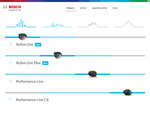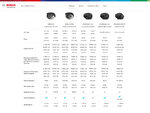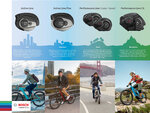Hi guys! I was in Irvine, California today visiting Bosch eBike Systems and got to test ride all of their motors back to back... so, I made a video about it! 2018 is the first year for the redesigned Active Line and Active Line Plus, which are extremely quiet. They are much lighter, physically smaller, and use a 1 to 1 chainring so pedaling with the bike off or above the top assisted speed of 20 mph isn't impacted by reduction gearing (as it is with the older Active Line motors and all current Performance Line motors. My experience has been that the reduction drag isn't that big of a deal, but it's something that does differentiate Bosch from all other mid-motor manufacturers except for TTIUM, which I reviewed last year on the PESU Monster.
Good things about Bosch Electric Bike Motors:




Other technical details about the Bosch drive system follow, all measurements are related to 2018 products and may describe prior years.

Good things about Bosch Electric Bike Motors:
- Extremely responsive (senses rear wheel speed, pedal cadence, and pedal torque, 1,000+ times per second)
- Offers shift detection (listens for pedal torque change and shifter tension changes to reduce motor power and protect your chain, sprockets, and derailleur)
- Very reliable, I hear e-bike shops tell me that they require less maintenance and that getting parts is relatively easy
- Excellent two-year warranty with many service centers
- One of the most expensive drive systems (becoming cheaper now that they have the less powerful Active Line options)
- Not compatible with any throttle systems, they only support Class 1 and Class 3 type of ebikes
- Relatively heavy at 8.8 lbs for the Performance Line drive units, the new Active Line are lighter at 7.1 and 6.3 lbs
- The Performance Line motors are louder because of the reduction gearing, and this also creates some friction and drag when unassisted or above motor supported speeds



Other technical details about the Bosch drive system follow, all measurements are related to 2018 products and may describe prior years.
- Performance Line motors and the first generation of Active Line have a 180 mm Q Factor or "thread point" which is the distance between the pedal attachment points on the crank arms, when measured parallel to the bottom bracket axle. This is somewhere in the middle when compared to the Yamaha PW-X with 168 mm, the Shimano E8000 with 175 mm, Brose T and S with 190 mm, and Panasonic with 207 mm. My understanding is that a traditional non-electric mountain bike Q Factor would be 147 mm, but with Plus sized tires and fat tires, many have become wider.
- Performance Line motors and the first generation of Active Line motors have a standard ISIS Drive splined spindle but the new smaller Active Line and Active Line Plus motors have a Bosch-developed Mini ISIS Drive splined spindle. What I'm talking about here is the design for how crank arms slide onto the spindle, splined designs offer more ridges than square tapered and as a result are sturdier, more reliable, and more responsive.
- Performance Line motors and the first generation of Active Line motors used a reduction gearing system that made the chainring turn 2.5 times for each crank revolution but the new smaller Active Line and Active Line Plus have a standard sized chainring that spins 1 to 1, does not introduce gearing friction when pedaling unassisted or above the maximum supported speed, and can be pedaled backwards to actually move the chain through the rear gearing setup whereas the other systems just freewheel backwards. I was told that one benefit of the older design was improved chain retention but I heard about some cases of chain suck and it definitely brought the chain closer to the right chain stay, causing increased contact and paint chipping on many frame designs. Part of what makes the new Active Line motors so compact and lightweight is that they do not contain as many gears.
Last edited: